
A quiche is a savory pie with a custard-based filling. Lorraine is a region in north-east France that has mixed German-French history and is called Lothringen in German. The word “quiche” comes from German “Küchen” (pie). According to wikipedia there are three types of quiche: Lorraine: with bacon (lardons) only, Vosgienne: with bacon and cheese, and Alsacienne: with bacon, onions and cheese. There is even a “Syndicat National de Défense et de Promotion de l’Authentique Quiche Lorraine” (National Society for the Protection and Promotion of the Authentic Quiche Lorraine) that says that an authentic Quiche Lorraine may only contain shortcrust pastry, egg, bacon, crême fraîche, pepper and nutmeg.
In practice, if you see a Quiche Lorraine it will always have bacon and may have cheese and/or onions as well. Thomas Keller’s “insanely delicious” Quiche Lorraine that I read about on REMCooks, is officially a Quiche Alsacienne. Richard calls it decadent, a lot of work, and incredibly good. I decided to give it a try, cutting some corners to make this a leisurely Sunday afternoon project and slightly less work. For the pastry I used the same approach as for the Pear Tart since that turned out so well. It was not as much work as I feared and the result was certainly decadent and delicious. Only the onion confit is more work (and takes more time) than any other quiche from scratch. The only thing I will change next time is to use a higher pie shape to get a higher custard-to-crust ratio. I may also try to do a quiche with crême fraîche rather than milk and heavy cream, to see whether the SNDPAQL has a point… Thanks to Richard McGary for the idea of making a quiche lorraine/alsacienne from scratch in the first place!
Ingredients
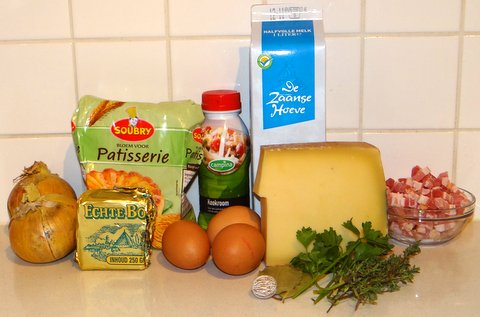
For 3-4 servings (I made about half of TK’s recipe)
For the crust
250 grams pastry flour (all-purpose flour will also work, but pastry flour gives a crispier/flakier crust)
125 grams cold butter
1/2 tsp salt
2-4 Tbsp ice water
For the batter
250 ml (1 cup) milk
250 ml (1 cup) heavy cream
3 eggs
1 tsp salt
freshly ground white pepper
freshly grated nutmeg
For the filling
225 grams (.5 lb) smoked bacon, cut into lardons
salt and freshly ground black pepper
1 tsp fresh thyme, minced
freshly grated Comté cheese (substitue with Gruyere)
For the onion confit
2 onions, sliced lengthwise (about 2 cups)
50 grams (4 Tbsp) butter
4 Tbsp water
1 bouquet garni (bay leaf + parsley + thyme)
1/2 tsp salt
Preparation

Start by making the onion confit. The key here is to make the onions soft, sweet, and fragrant without caramelizing them. Heat 50 grams butter with 4 Tbsp cold water over low heat.

Stir until the butter has melted.

Add the onions, 1/2 tsp salt, and the bouquet garni. A bouquet garni is few sprigs of fresh thyme and parsley held together by a bay leaf. Since I only had dried bay leaves on hand, which can’t be bent without breaking them, I improvised a little and used two bay leaves with the parsley and thyme in between. The point of the bouquet garni is that you can easily take it all out at the end of the cooking, without having bits of thyme and parsley everywhere in the finished dish.

Make a parchment paper lid by cutting a circle of parchment paper that fits exactly into your pan.

Cut a whole in the middle by folding it in 8ths and cutting of the tip (only 1 cm or 1/2 inch is plenty, I cut off slightly too much).

Put the parchment lid on the onions and gently push it down. This helps to prevent too much evaporation.

Cook the onion confit for two hours (!) over very low heat, stirring and checking every 20-30 minutes and adding a bit of water if needed. You don’t want the onions to caramelize, so the heat should really be very low and there should always be a bit of water left. (The presence of liquid water limits the temperature to 100C/212F, and caramelizing cannot happen at temperatures under 150C/300F. But as soon as the water is gone, such temperatures can be reached very quickly. So check periodically, a bit more often towards the end of the two hours.) The onions should become tender without falling apart.

Make the crust while the onion is cooking. Start by sieving the flour.

Put the flour into the food processor. Add the butter in cubes.

Use the ‘pulse’ until pea-sized pieces of butter remain. Drizzle with ice water.

Pulse until the dough starts to come together. Add more ice water if needed (the exact amount depends on factors like the humidity of the flour and the air). Do not process more than necessary.

Gather the dough into a ball. Sprinkle a work surface with flour.

Roll out the dough to the size of your pie shape including the edges (so for a 23 cm pie shape with 2.5 cm edges, you need a circle with a diameter of 23 + 2.5 + 2.5 = 28 cm).

Butter a pie shape and transfer the dough. It is easier to transfer when you gently fold it in half.
I used a 27 cm (11″) pie shape, but next time I will use a smaller one (24 cm/9″ or even less) to make the quiche higher and thus get a higer ratio of custard to crust.

Line the pie shape with the pastry crust. Here I made the mistake to trim the edges right away. It is easier to trim the edges after baking the pie, because you want to fill it to the brim with the custard and then when you have to move the pie shape to put it into the oven, the batter will overflow unless you move it very slowly.
Let the unbaked pastry crust rest in the refrigerator for at least an hour. This helps to relax the gluten to prevent shrinking and make the crust more crispy and flaky. It’s even better to let it rest overnight like in TK’s recipe, but I didn’t have time for that and it still turned out well: crispy and flaky with just a tiny bit of shrinkage.

After resting the dough in the refrigerator it is time to bake it without filling. Preheat the oven to 190C/375F.
Line the crust with parchment paper and fill it with pie weights (ceramic balls like I used, or dried beans or even rice).
Bake for 35 minutes at 190C/375F.

Remove the pie weights and parchment paper. Make a few small holes in the crust with a fork, and put it back into the oven at 190C/375F.

Bake for 15-20 minutes until golden brown. Take out of the oven and allow to cool.

Put the bacon on a baking sheet with parchment paper and bake for 5-10 minutes at 190C/375F.

Most of the fat should render from the bacon, but it should not crisp.
Take the bacon out of the oven and lower the oven temperature to 160C/325F.

Transfer the bacon to paper towels to drain, using a slotted spoon.

Add the bacon to the onions. Add thyme and season with salt and freshly ground black pepper. Stir to mix.

Spread out the filling on the pie crust. If you have a smaller pie crust, you may want to do this in two layers. But since I had a wide pie crust, it was one layer for me.

Cover with a nice layer of freshly grated comté cheese.

Make the batter by putting milk, heavy cream, salt, freshly ground white pepper, and freshly grated nutmeg into the blender or mixer.
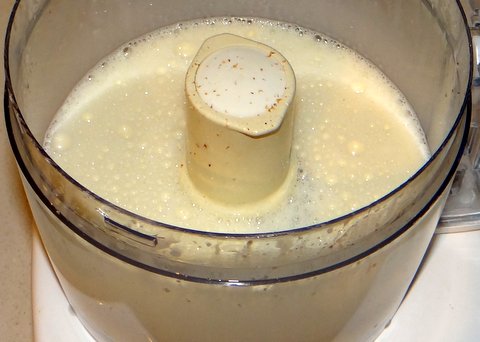
Blend for a couple of minutes until well mixed and foamy.
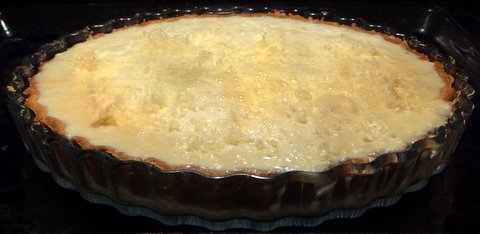
Pour batter on the filling. Top with more freshly grated comté cheese.
Bake at 160C/325F until the custard has set. Because I made a low quiche it was done in an hour, but if you fill it in two layers it may take 90 minutes or longer.
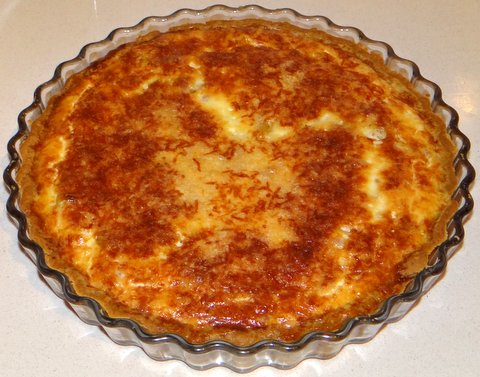
You could serve it straight away, but TK advises to improve the flavor by allowing the quiche to coold and to refrigerate it for 1-3 days first.

To serve, cut slices out of the quiche and reheat them at 190C/375F for 15 minutes.
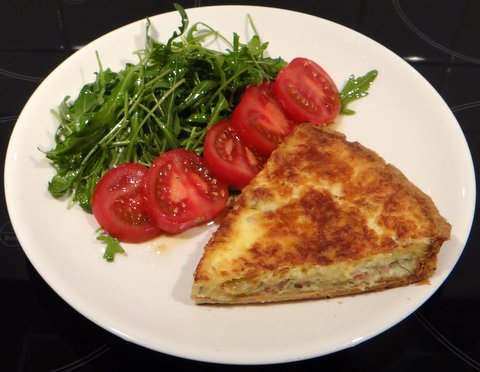
Serve with lettuce and tomatoes and French vinaigrette (5 Tbsp extra virgin olive oil, 2 Tbsp wine vinegar, 1 tsp Dijon mustard, salt and freshly ground black pepper, beaten until emulsified).
Wine pairing
A full-bodied dry white wine from the region (i.e. Alsace) is a great match for a quiche alsacienne. A pinot gris matches the smokiness of the bacon best, but pinot blanc or riesling should also work. The vinaigrette may be difficult to pair though.


Good pastry tips!
LikeLike
The keller recipe is a bit of a fuss (we’ve made it), we like your version better. And while it does make it better, who wants to wait 1-3 days?
LikeLike
This time it was convenient for me to wait 2 days. Next time I’ll have to remember to try a slice when it just comes out of the oven to compare.
It’s funny actually, usually *I* am called fussy, but apparently Keller is even more fussy 😉
LikeLike
I never thought of putting cheese or onions in Quiche Lorraine… Interesting. I’ll have to try your version
LikeLike
Apparently it is always served like that in the USA.
I haven’t eaten enough Quiche Lorraine in France to know what is usual there.
LikeLike
Hi, Stefan. Looks great! Seems as if I have been making and eating Quiche Alsacienne all of these years! I wonder how when it came to the US Quiche Lorraine became Quiche Alsacienne? If you order Quiche Lorraine at any American restaurant, it will come with onions and cheese. I guess a little bit more research is in order. 😉
LikeLike
What baffled me even more is that when you order an entrée in any American restaurant, you will get a main course rather than an appetizer (which is what it means in French). Or that Fettucine Alfredo, Gamberi Fra’ Diavolo, and Chicken Parmigiana are not eaten in Italy 😉
I’m not even sure how strict the French are with quiche names, since I never took notice before (I will though, next time I’m in France). I did notice that quiche with other fillings (but still a pastry crust with egg custard and a savory filling) are usually called tarte rather than quiche.
LikeLike
“Tarte” is a French word; “quiche” is Alsatian, derived from German “kueche”
LikeLiked by 1 person
That is incorrect. Fettucine Alfredo for example is a classic italian dish (check “Ristorante Alfredo alla Scroffa” in Rome, the original creators of this dish).
It is correct though, that the americanized versions would NEVER be served in italy (check the video of the Ristorante’s staff reacting to americanized versions of their recipe, it is hilarious).
LikeLike
Hi Balthasar, I don’t agree. The Fettuccine Alfredo that is served all over the US is by no means a classic Italian dish. My definition of a classic Italian dish is that is considered to be a “piatto tipico” in Italy. The dish is so simple that it is nonsense to say it was ‘created’ by Ristorante Alfredo in Rome, because it is simply egg noodles with butter and parmigiano. In Italy that is a pretty classic/standard dish, but then it is simply called “fettuccine burro e parmigiano” and many Italians do not know what “Fettuccine Alfredo” is and it is never on restaurant menus under that name (unless perhaps restaurants that cater to American tourists). If you look for “piatti tipici” from Rome, you will never see Fettuccine Alfredo or even fettucine burro e parmigiano on that list. Instead you will find Carbonara, Cacio e Pepe, Gricia, and Amatriciana.
LikeLike
That is so funny! I was going to post about quiche today but you beat me to it. So I changed to candy. I love the Thomas Keller one – yes, it’s a bit fussy but it ends up so creamy. His dough, though, is a bit of a nightmare: very very flaky, to the point that it is impossible to cut it. I also substitute with mine. Recently I made a very un-French one with goat cheese and sundried tomatoes.
LikeLike
That was certainly un-Lorraine or un-Alsace, but in the Provence they would call it Tarte Chèvre et Tomates Séchées and might add some olives, too 😉 Even when there are eggs in such a tarte, they still call it tarte rather than quiche. Perhaps because a quiche has to be from the region where they used to say Küchen?
LikeLike
P.S. Would still love to read what you have to say about quiche…
LikeLike
Well, Thomas Keller suggests blending the eggs and cream or creme fraiche in a blender and I do have to say that it does add an extra fluffiness to the filling. Try it next time
LikeLike
Thanks. I did use the magimix, but I could make it more fluffy by using a blender next time.
LikeLike
As good as Richard’s quiche certainly was, your version does seem a bit more “doable.” Both are still a bit of work and I bet either would be perfect for Sunday brunch. Good work, Stefan!
LikeLike
Thanks, John!
LikeLike